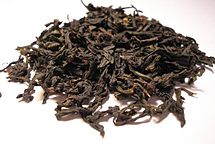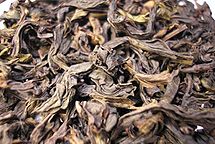- Da Hong Pao
-
Da Hong Pao 

Type: Oolong Other names: Large Red Robe (and synonyms), Ta Hong Pao, 大红袍 Origin: Mount Wuyi, Fujian Province, China Quick description: Most famous of the Mount Wuyi teas
Dà Hóng Páo (大红袍, lit.: "Big Red Robe") is an important Wuyi Oolong tea. According to legend, the mother of a Ming Dynasty emperor was cured of an illness by a certain tea, and that emperor sent great red robes to clothe the four bushes from which that tea originated. Three of these original bushes, growing on a rock on Mount Wuyi and reportedly dates back to the Song Dynasty, still survive today and are highly venerated. At one point, less than one kilogram of tea was harvested from these plants each year, of which a portion was retained by the Chinese government. In 2005, the remainder of this original and real Da Hong Pao was auctioned, with an initial asking price of 4000 RMB/100 g, but often reaching tens of thousands to millions of dollars per kilogram[1][2]In 1972, US President Nixon received 50g of Dà Hóng Páo, or half of China's reserve that year, at the estimated cost of 250,000 US Dollars in 2011 money.[3]
In recent years, a number of companies have invested in preserving the interest in this tea and other so-called "artisan" teas, which typically are of very high quality and have rich histories as is true with Da Hong Pao. These have an initially high cost of production (and typically are only considered authentic when grown in their place of origin), but, as they have quickly become popular in Western countries, prized selections of the tea are available each year, with quality being consistent due to the increased popularity of tea.
Cuttings taken from the original plants have been used to produce similar grades of tea from genetically identical plants. Taste variations produced by processing, differences in the soil, and location of these later generation plants is used to grade the quality of various Da Hong Pao teas.
Xiao Hong Pao, or Small Red Robe refers to Da Hong Pao grown from plants of fourth or greater generation, but the term is rarely used. In some cases Xiao Hong Pao is simply sold as Hong Pao, presumably for marketing purposes.
Due to its high quality, Da Hong Pao tea is usually reserved for honored guests in China.
References
- Babelcarp on Da Hong Pao
- Master Lam Kam Cheun et al. (2002). The way of tea. Gaia Books. ISBN 1-85675-143-0.
Tea Black tea Oolong tea - Bai Ji Guan
- Red Robe
- Darjeeling Oolong
- Dongding (Tung-ting)
- Dong Fang Mei Ren
- Huangjin Gui (Golden Osmanthus)
- Qilan tea
- Pouchong
- Rou Gui
- Shui Jin Gui
- Shui Hsien (Shui Xian)
- Tie Luohan
- Tieguanyin (Iron Goddess)
Green tea - Aracha
- Bancha
- Green Spiral
- Chun Mee
- Da Fang
- Genmaicha
- Liuan Leaf
- Gunpowder
- Gyokuro
- Hojicha
- Hou Kui
- Huang Shan Mao Feng
- Hyson
- Kabusecha
- Kamairicha
- Konacha
- Kukicha
- Longjing (Dragon Well)
- Matcha
- Mao Jian
- Mecha
- Meng Ding Gan Lu
- Sencha
- Shincha
- Tamaryokucha
White tea Yellow tea Post-fermented tea Blended and
flavoured teasTea culture Tea beverages Other - Camellia sinensis (tea plant)
- Tea bag
- Teapot
- Consumption
- Flowering tea
- Glass-holder
- Health effects
- Tea processing
- Samovar
- Tea brick
- Tea garden
- Tea house
- Tea tasting
- Teakettle
See also Categories:- Wuyi tea
- Chinese tea
- Chinese tea grown in Fujian
- China famous tea
Wikimedia Foundation. 2010.

